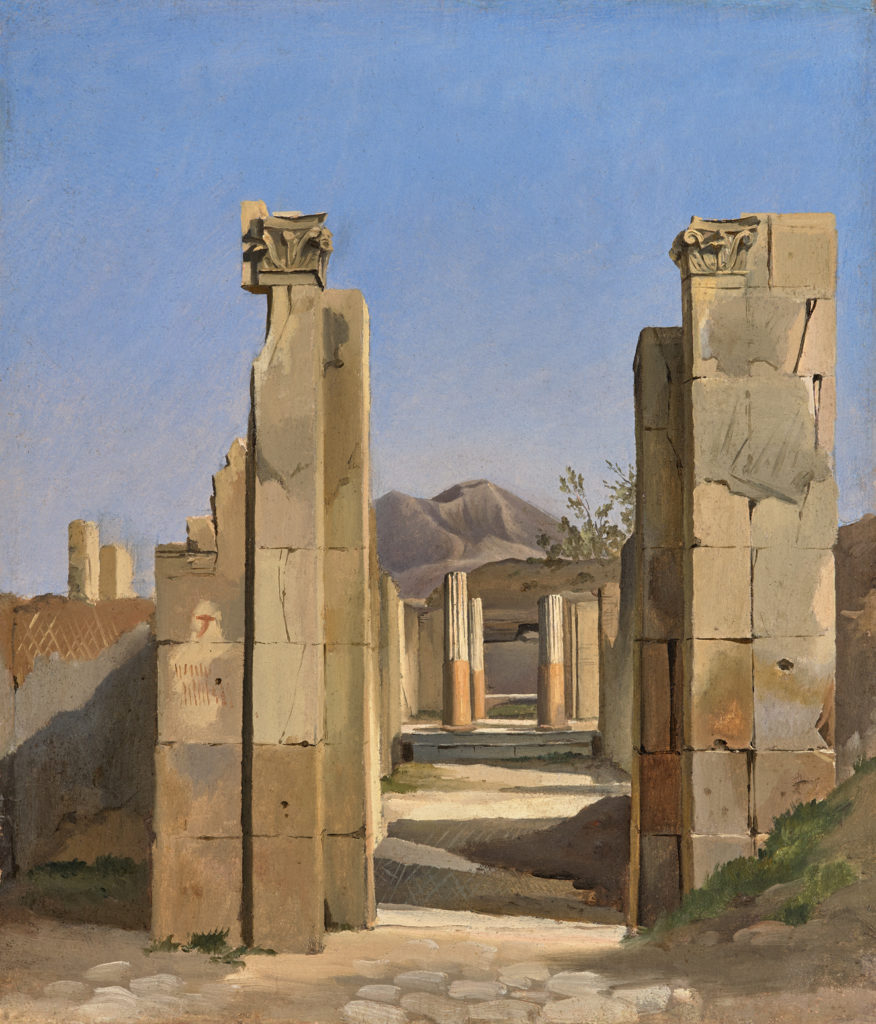Charles Gleyre attributed (Chevilly 1806 - 1874 Paris)
Entrance to the House of Pansa, Pompeii, April 1834 or after
Oil on paper laid down on canvas, 35 x 28.5 cm
Provenance:
Private collection, Geneva
The painter Charles Gleyre was born in Chevilly, Switzerland in 1806 and was a staunch Republican and citizen of the Swiss (Helvetic) Confederation his whole life. The Musée d’Orsay in Paris devoted an extensive exhibition to his work in 2016.[1]
After attending the drawing school in Lyon, Gleyre enrolled in the Ecole des Beaux-Arts in Paris in 1825. In 1828 he went to Italy to continue his studies. Through a dist
ant relative, François Keiserman – a Swiss painter who specialized in vedute – he became acquainted with such artists as Léopold Robert and Horace Vernet, then director of the Academie de France in Rome. Robert, who had great success in Rome with his scenes of brigands, inspired Gleyre to paint this theme in his first important painting, The Roman Brigands, in 1831. Gleyre’s lack of success in Rome prompted him to enter the service of the wealthy American industrialist and philanthropist John Lowell Jr. (1799-1836),[2] with whom he embarked on a journey to the Orient in 1834. The drawings he made for Lowell include sights, landscapes, ethnic dress and folk scenes, captured from life. This three-year journey, which took Gleyre from Italy to the Sudan and on to Beirut, was a once-in-a-lifetime adventure. After eighteen exhausting months, he and Lowell parted company in Khartum, and Gleyre traveled back to France, where he arrived two years later.
Based on the recollections in his travel journals and the studies he made on this journey – in 1840 Lowell’s heirs gave Gleyre permission to use the sheets for his own purposes – he worked on the Orientalist paintings that led to the breakthrough in his career. The Evening, exhibited with great success at the Salon of 1843, paved his way to the “Grand Genre,” as the highly esteemed genre of history painting was still called in France. That same year he took over Paul Delaroche’s studio and later became the teacher of such famous painters as Jean-Léon Gérôme, Claude Monet and Auguste Renoir.
Naples and its vicinity were Lowell and Gleyre’s first stop on their journey to the Orient. Drawings and watercolors are known which Gleyre produced in Pompeii on 28 and 29 April 1834.[3] Our small work in oil on paper could have been made during their stay in Naples or afterwards. It depicts the entrance area to the so-called Casa di Pansa on the Via delle Terme and the entire depth of the house with a view of Vesuvius in the background. Excavation work began in 1810 on the estate of Gnaeus Aleius Nigidius Maius, considered one of the most important men in Pompeii.[4] An amusing detail is the red graffiti from Roman times, traces of which can be seen on the left pilaster of the entranceway.
[1] Exhibition Charles Gleyre (1806-1874). Le romantique repenti, Musée d’Orsay, Paris, 10 May - 11 September 2016. [2] Founder of the Lowell Institute, Boston: https://en.wikipedia.org/wiki/John_Lowell,_Jr._(philanthropist) (2 September 2016) [3] Cf. William Hauptman, Charles Gleyre 1806-1874. I Life and Works. II Catalogue raisonné, Princeton 1996, p. 74. [4] Cf. Ludwig Lohde (ed.), Jules Gailhabaud’s Denkmäler der Baukunst, vol. 1, Leipzig, Munich 1852, pp. 239-241.

